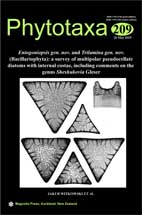Abstract
We present the results of an extensive light-(LM) and scanning electron microscope (SEM) study of internally costate pseudocellate multipolar diatoms previously placed within Biddulphia, Entogonia, Sheshukovia and Triceratium. For the first time, we critically examine the poorly known genus Sheshukovia. We find that the separation of Sheshukovia from Triceratium is justified, as advocated by Gleser (1975, 1984), but also show that Sheshukovia as circumscribed by Gleser (1975, 1984) is a heterogenous taxon comprising at least three morphologically distinct groups. In order to clarify the confused taxonomy of pseudocellate multipolar diatoms, a preliminary phylogenetic analysis is presented, including Triceratium, Sheshukovia, Entogonia, Medlinia and two new closely related genera proposed here: Entogoniopsis and Trilamina. Both new genera have valvocopulae that attach to costae on the valve interior by means of a variety of clasping devices. Entogoniopsisis is characterized by areolate valves and a twofold mechanism for valvocopula attachment, whereas Trilamina possesses extensive hyaline areas and a threefold valvocopula attachment mechanism. The twofold mechanism for valvocopula attachment in Entogoniopsis, and the threefold valvocopula attachment mechanism in Trilamina are here considered synapomorphies supporting the monophyly of the respective taxon. The morphology of 19 species, four of which are new, is documented using both LM and SEM and a further 18 taxa are transferred from elsewhere, observations being based on literature survey and/or LM examination. When original material is available, taxa are typified. Two new morphological terms are proposed: a trifolium is a triradiate raised sector located in the central part of undulate valve faces in some species of Entogoniopsis; a fossa is a circumferential invagination of the advalvar edge of the valcocopula. These features are found in both new genera proposed herein.

